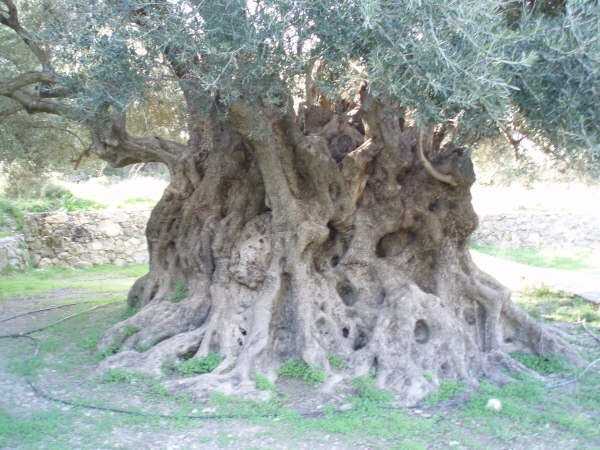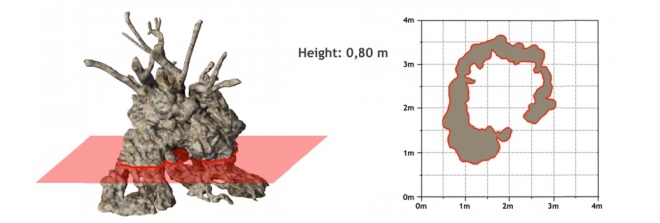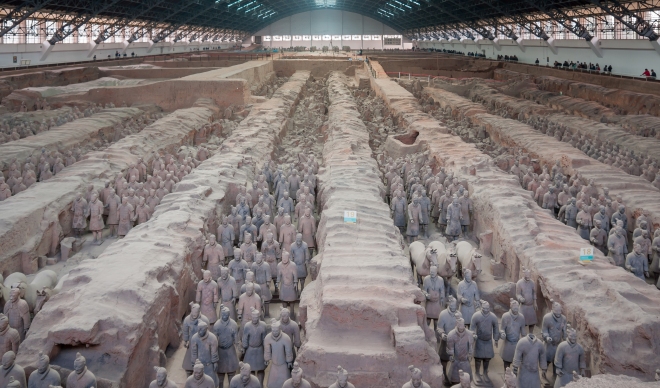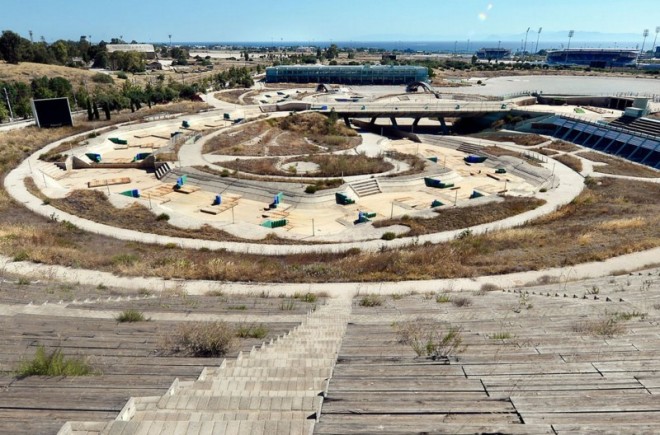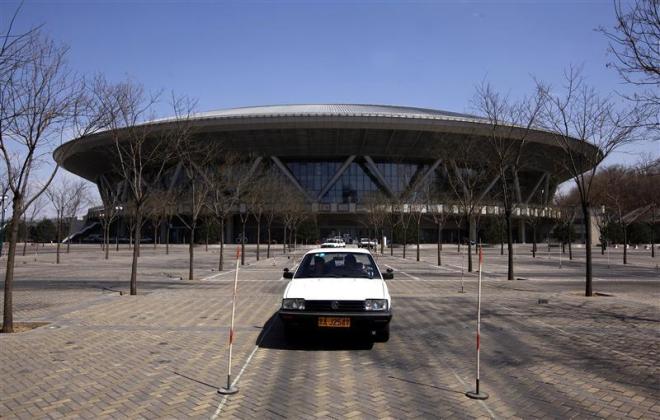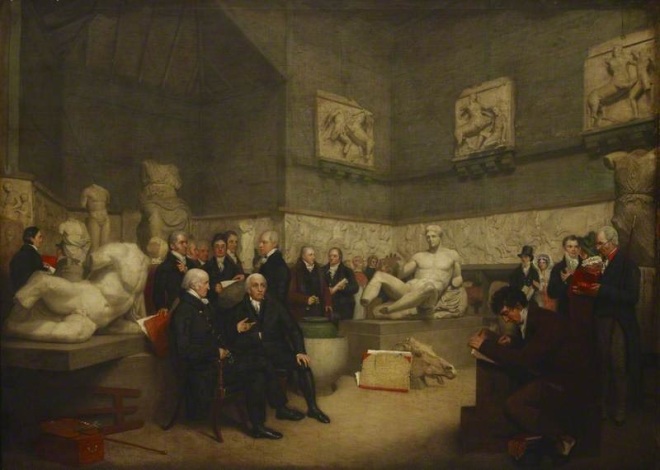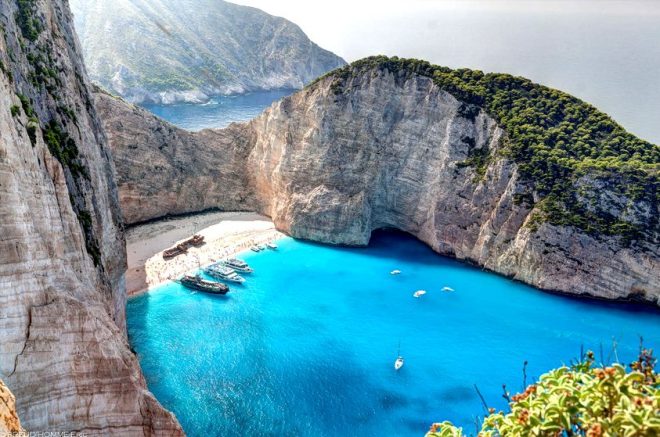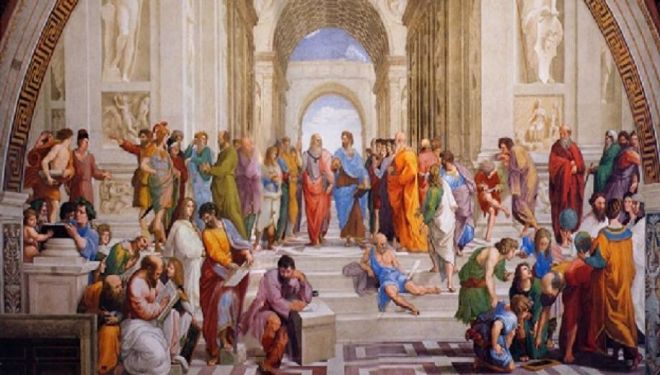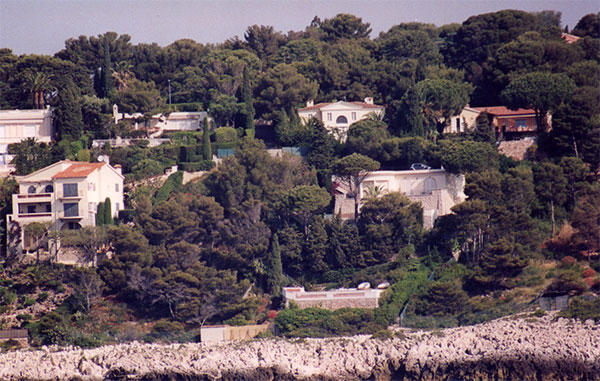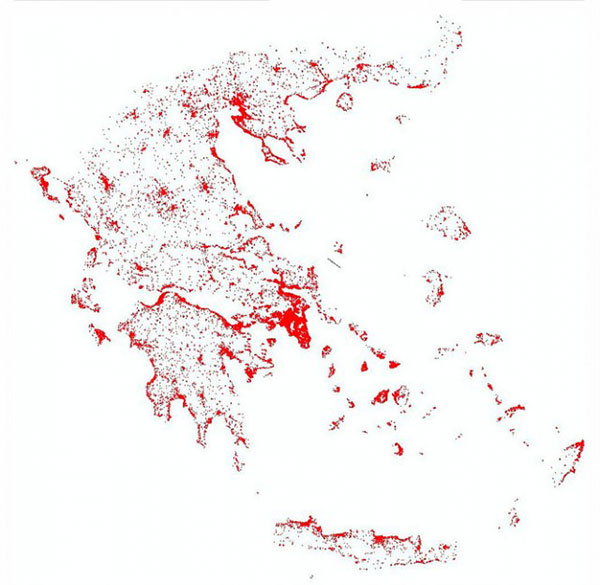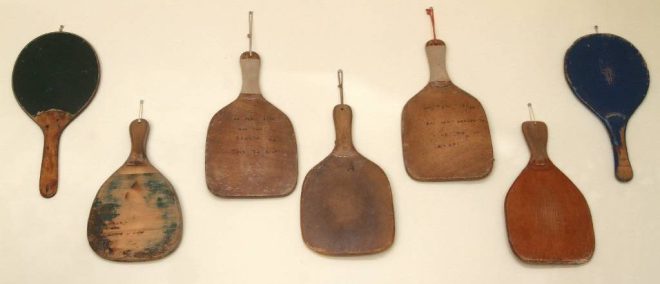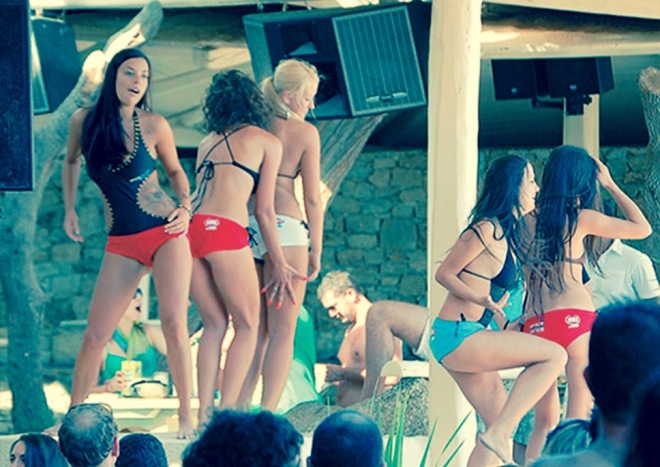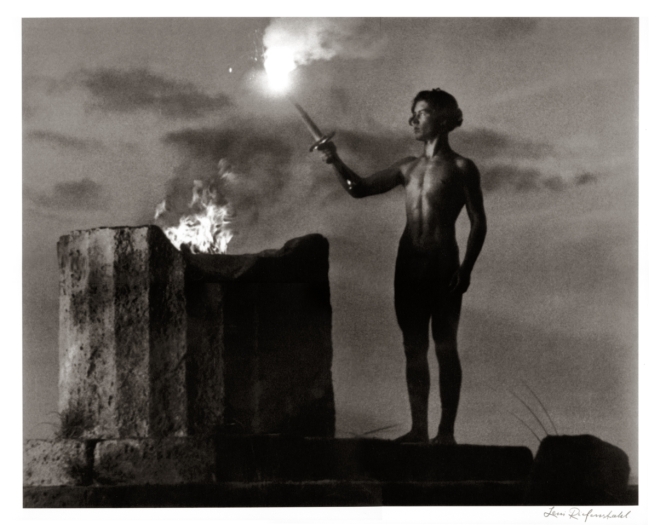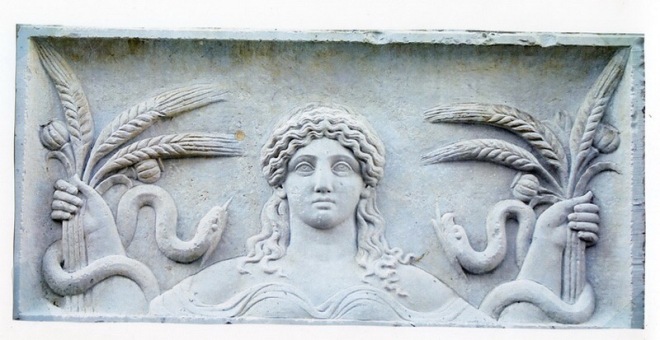
I recently tried to take a break from the snark, cynicism and political intrigue that normally fuel this blog by sketching out a proposal for an essay combining two of my other interests: ancient stuff and food. A whimsical yet informative look at the revival of ancient foods, I thought, a good news story about rediscovering the past in the crisis, peppered with incidental historical detail and toothsome gastronomic tips.
But would “they” let me? The hell they would!
When I say “they” I am referring not to the voices in my head, but to my tirelessly inventive friends, the conspiracy theorists. I had forgotten Rule Number One: no topic, no matter how benign or obscure, is conspiracy-proof. Especially in Greece.
If you have visited a Greek health food shop recently, or any of the new generation of “traditional” delis, you will have been struck by the incredible array of dried pasta, a lot of it made in Greece from various obscure rustic grains. And if you happen to have read any literature on the origins of agriculture, some of these grains will sound familiar: δίκοκκο σιτάρι (Triticum dicoccum); spelt (Triticum spelta) often labelled by its German name, dinkel; and the more classical-sounding “Zea”. A veritable cornucopia of archaeobotanical samples seems to have taken over the shelves overnight, despite the hefty price tag that many of them command.
I was curious as to what had spurred this new market, particularly given that it coincides with a dramatic contraction in the average household’s spending power. So, naively I typed “ζέα καλλιέργεια” (“zea cultivation”) into Google. I was expecting to find official web pages from the Ministry of Agriculture about subsidy schemes, perhaps some farming publications discussing yield and soil types, and maybe a few food blogs of the “knit your own yoghurt” variety.
Instead I was confronted by a whole slew of articles with titles like “Zea, a well-made fairytale”, “What is zea and why it was banned in Greece”, “Bread from ZEA flour – READ the WHOLE TRUTH”. The random capitalisation signals it loud and clear: there is a TRUTH about zea that THEY don’t want you to know. The comments sections played host to some fairly disturbing flame wars, too – easily a match for an anti-vaccine bulletin board or a bitcoin forum. So much passion and anger for a humble little grain!
Without much effort, I traced the source of the conspiracy stories. “The Historic Swindle” (Ο ΙΣΤΟΡΙΚΟΣ ΕΜΠΑΙΓΜΟΣ) by one General George G. Aïfantes, published in 2010 in archaïzing katharevousa Greek (the linguistic affectation of choice of the reactionary), now sadly out of print, is a classic of its genre. To cut a long and meandering story short, the book is an explication of how the great world powers conspired to destroy Greece over a century ago, with clearly telegraphed topical parallels to more recent events.
I will let the author explain in his words, translated verbatim below for the extensive passages quoted on various websites like this one (epilepsy warning!), with the original punctuation:
«Οί αρχαίοι δέν έτρωγαν ψωμί άπό σιτάρι. Τό σιτάρι τό είχαν ώς τροφή τών ζώων καί τό (ονόμαζαν πυρρό. Έτρωγαν μόνον ψωμί άπό Ζειά ή Κριθάρι καί έν ανάγκη μόνον από κριθάρι ανάμεικτο με Σιτάρι. Ό Μέγας Αλέξανδρος έτρεφε την στρατιάν του μόνο μέ Ζειά, διά νά είναι οι άνδρες του υγιείς και πνευματικά ανεπτυγμένοι. Αν οι αρχαίοι Έλληνες έτρωγαν ψωμί άπό σιτάρι δέν θά είχαν τόσο ύψηλήν πνευματικήν άνάπτυξιν.»
“The ancients did not eat bread from wheat. Wheat they used as animal feed and they named it πυρρό. They ate only bread from Zeia or barley, and only in emergencies from barley mixed with Wheat. Alexander the Great fed his army only on Zeia, in order that his men be healthy and mentally developed. Had the ancient Greeks eaten bread from wheat they would not have such a high level of intellectual development.”
«Μόλις οι κοσμοκράτορες έδιάβασαν αυτήν τήν έκθεσιν τής επιτροπής, δίδουν εντολή το 1928 νά αναιρεθή αμέσως ή καλλιέργεια Ζειά στην Ελλάδα, και μόνον στην Ελλάδα. Διά νά μειώσουν μέ το σιτάρι τήν πνευματικήν άνάπτυξιν των Ελλήνων, μειώνοντας τήν άντίληψίν τους και οργανώνοντας ταπεινήν έκπαίδευσιν των παιδιών τους καί διδάσκοντας τις πολιτικές τους εις τά σχολεία και πολιτικοποιούντες τα εις τά κόμματα που αυτοί ελέγχουν απόλυτα, για νά ποδηγετήσουν πλήρως εις πρώτον χρόνον τους Έλληνας. Ενώ τώρα αναμειγνύοντας τους μέ αλλοδαπούς, θέλουν νά τους εξαφανίσουν τελείως.»
“As soon as the world rulers read this report of the committee, they issued an order in 1928 to cease immediately the cultivation of Zeia in Greece, and in Greece only. So as to reduce with wheat the intellectual development of the Greeks, reducing their understanding and organising debased education for their children and teaching them their politics in the schools and organising them into political parties that they controlled absolutely, so as to control the Greeks in the shortest time. Whereas now mixing them with foreigners, they want to eradicate them completely.”
«Ναι άλλα πώς θά τό επιτύχουν αυτό;Αμέσως δίδουν έντολήν είς τόν τέκνον των τον Βενιζέλο νά έπιστρέψη στην Ελλάδα καί νά εξαφάνιση τήν Ζειά. Οπότε βλέπουμε τόν Βενιζέλο νά έπιστρέφη στην Ελλάδα μετά άπό 8 χρόνια αυτοεξορίας του, νά άνασκουμπώνεται και νά ορμά σάν λέων κατά τής Ζειάς. Μέσα σέ 60 χρόνια μόνον ήλλοίωσαν τήν πνευματικήν ύπεροχήν του σκέπτεσθαι τών Ελλήνων, τους έκαναν αδιάφορους, άβουλους, μέ μετρίαν αντίληψιν και φιλάσθενους καί τώρα μέ τους αλλοδαπούς επιδιώκουν τόν πλήρη εξαφανισμό τής φυλής των, ένώ συγχρόνως ξοδεύουν δισεκατομμύρια δολλάρια οι φιλεύσπλαχνοι διά νά μην εξαφανισθούν οί οχιές, κόμπρες, πάντα καί άλλα ζώα καί ερπετά.»
“Yes but how will they achieve this? Immediately they issue an order to their child Venizelos to return to Greece and eradicate Zeia. So we see Venizelos returning to Greece after 8 years’ self-exile, rolling up his sleeves and setting upon Zeia like a lion. Within a mere 60 years they corrupted the intellectual superiority of Greek thought, they made Greeks indifferent, timid, with mediocre understanding and sickly and now with the foreigners they are intending the complete eradication of their race, while simultaneously the benevolent are spending billions of dollars to prevent the disappearance of vipers, cobras and all other animals and reptiles.”
«Προς το τέλος του 1928 ο “Εθνάρχης” μας Βενιζέλος, προφανώς μετά από κάποια εντολή, με της Αμύνης τα Παιδιά, τυφλά εις τον νουν και την κρίσιν και διψασμένα το πώς να ευχαριστήσουν καλλίτερα τον αρχηγόν των εκήρυξαν τον πόλεμον κατά της Ζειάς και εφορμήσαντες ακαταμάχητοι, ενίκησαν νίκην λαμπράν και εις βραχύτατον χρόνον 4 ετών δεν υπήρχε εις την Ελλάδα ούτε ένα σπυρί Ζειάς για σπόρο. Είπαν εις τον λαό ότι η Ζειά είναι ζωοτροφή, δι αυτό τα λεξικά την γράφουν έκτοτε ζωοτροφή και ότι είναι βλαβερή στην υγεία. Αυτό το πρόβαλαν έντονα τα Μ.Μ.Ε. και σε 4 χρόνια εξηφανίσθη η Ζειά.»
“Towards the end of 1928 our “Ethnarch” [sic] Venizelos, clearly acting on instruction, with his “boys in Defence” [an ironic reference to a pro-Venizelos anti-royalist song of the time], blind of mind and judgement and thirsting for how to best please their leader declared war on Zeia and charging forth invincible, won a glorious battle and in a brief 4 years there was not left in Greece a single grain of Zeia for planting. They told the people that Zeia is animal feed, and for this reasons since that time the dictionaries have it as animal feed and write that it is harmful to health. This was promoted strenuously in the Mass Media, and within 4 years Zeia had disappeared.”
The General goes on to say that Venizelos also expunged any reference of Zea from Greek dictionaries, and that his friends made a killing importing wheat into Greece on the back of the Zea ban. But that is not all. He also gives a vivid description of how gluten is used by “the establishment” to breed compliant slaves to the system. “Here comes the science!” as Jennifer Aniston used to say in the those shampoo ads – look away now if you know anything about molecular biology:
«Η γλουτένη του σιταριού καταστρέφει την υγείαν, το πνεύμα, την μεγαλοφυίαν, τον πολιτισμόν της ανθρωπότητος, διότι ως ισχυρή κόλλα επικολλάται εις τα τοιχώματα όλων των αγγείων πού διέρχεται, πεπτικούς σωλήνες, έντερα, φλέβες, αρτηρίες κ.λπ. Ένεκα τούτου παρακωλύει την σωστήν πέψιν, τις κενώσεις και την κυκλοφορίαν του αίματος, με τις αντίστοιχες επιβαρύνσεις εις την υγείαν.»
“Wheat gluten destroys the health, the spirit, the genius and civilisation of mankind, because as a strong glue it fixes itself to the walls of all vessels that it passes through, digestive tracts, guts, veins, arteries etc. Because of this it prevents proper digestion, excretion, blood circulation, with the corresponding detriments to health.”
«Εις τον εγκέφαλον ως πρωτεΐνη στηρίξεως κολλά ισχυρά τις πρωτεΐνες της μνήμης με αποτέλεσμα, ότι παραστάσεις και ιδέες εβίωσεν το παιδί εις την ηλικίαν 3-7 ετών, οσο λανθασμένες και αν είναι, οσο πιο δυνατές και ξεκάθαρες αποδείξεις περί πλάνης του και αν του παρουσιάσεις αργότερα, δεν πρόκειται ως ενήλικας να απορρίψη τις αποθηκευμένες μνήμες και δοξασίες του, περί θεού, πολιτικής, κ.λπ.»
“In the brain as a structural protein it fixes solidly the proteins of memory with the result that, whatever attestations and ideas the child experienced at the age of 3-7 years, however mistaken they may be, however powerful and clear proof of their fallacy you present later, it will not as an adult reject its stored memories and beliefs about god, politics, etc.”
«Δι’ αυτό ακριβώς οι θρησκείες, οι Δικτάτορες, οι έξουσιασταί μας με διάφορα τεχνάσματα και ωραία λόγια προσπαθούν να ποδηγετήσουν τα παιδιά απο μικρή ηλικία και εσοφίστηκαν τα κατηχητικά και τις πολιτικές νεολαίες. Οι Δικτάτορες και οι τραπεζίτες εισήγαγον την πολιτικήν εις τα σχολεία με πρόφασιν, δήθεν, την προπαρασκευήν ενήμερων πολιτών, ενώ στην ουσία εκπαιδεύουν τυφλούς δούλους του τραπεζικού συστήματος.»
“This is exactly why religions, Dictators, our masters with various ploys and beautiful words attempt to manipulate our children from a young age, and devised Sunday schools and political youth movements. The Dictators and banker introduced politics into schools with the pretext of, ostensibly, producing informed citizens, but in reality they are training blind slaves of the banking system.”
«Όποιος απο εσάς πιστεύει εις την ανεξάρτητον σκέψιν των ανθρώπων, ας αγωνισθή δια την κατάργησιν του συνδικαλισμού εις ολα τα σχολεία, πλην των πανεπιστημίων. Επομένως η γλουτένη του σιταριού είναι και η τροχοπέδη της εξελίξεως και του πολιτισμού. Ταυτοχρόνως, τροχοπεδεί και την ελευθέραν σκέψιν και πνευματικήν άνοδον του άνθρωπου και τον καθιστά δούλον του ιερατείου, του κατεστημένου, διότι αγωνίζεται και θυσιάζεται δια αξίας που του ενέπνευσαν τα οργανωμένα συμφέροντα και όχι η φύσις. Είναι όλοι οι αγώνες του εναντίον των φυσικών νόμων. Αντίθετα η πρωτεΐνη στηρίξεως της Ζειάς (πληθυντικός Ζειαΐ) διασπάται απο τα ένζυμα και αφομοιώνεται σαν καλή τροφή απο τον οργανισμό.»
“Whoever among you believes in the independent thought of people, must struggle for the abolition of unionisation in all schools, with the exception of universities. Therefore wheat gluten is a brake on development and civilisation. Simultaneously it acts as a brake on the free thought and spiritual elevation of man and makes him a slave to the priesthood, to the establishment, because he fights and sacrifices himself for values that were inspired in him by organised interests and not by nature. All of his struggles are against the laws of nature. In contrast, the structural protein of Zeia (plural Zeiai) is broken up by the enzymes and absorbed as a good food by the body.”
No doubt the General found an eager readership in the intersection between those the 75 percent of our countrymen who apparently believe that the financial crisis was engineered by conspiracy against Greece by outside forces, the one in three who are convinced that “we are being sprayed”, and the uncounted hypochondriacs who buy water purification kits off TV informercials while speed-dialling the astrology hotline. The Zea conspiracy certainly found traction on the Greek fringe nationalist internet and its affiliated TV stations, where the General appeared regularly as a pundit. For what could be more patriotic than reviving the (alleged) food of Alexander’s troops that was (allegedly) banned by the Great Powers, and that (supposedly) boosts not just your bodily functions but also your IQ so that you can make Greece great again?

The critics are equally vehement: Zea is a scam invented by profiteering farmers. It isn’t certified, and much of it is probably imported from Germany, fraudulently “Hellenised”, and inflated in price. It is nothing but the latest snake-oil put on the market to rip off gullible Greeks. It is bringing in GMOs by the back door. All references to zea attributed to ancient texts are invented or distorted. We are being sold grain that our ancestors barely saw fit for animal feed.
After consuming this rich fare, going back to writing about how “comeback grains” do offer some modest health benefits “as part of a balanced diet”, and how they may give farmers a new income stream, feels like swapping a big juicy double gyro wrap “with everything” for a virtuous bowl of all-organic, 100% vegan, gluten-free gruel. It’s a tough call. But at the end of the day, there is no sinister Zea abolition act in the parliamentary record, just the first modern food testing and standardisation regime, introduced in Greece 1928 (no matter how you choose to label it when you upload it to the internet). Nor does the accumulated knowledge of classical literature and archaeology support the General’s assertions that a crop called “Zea” was a staple of the ancient Greek diet and that wheat was not. As for the “science”, it belongs firmly in inverted commas along with Grain Brain, Wheat Belly and whatever other tome your orthorexic friend is is beating you about the head with this week. Eating whole grains will give you a healthier gut, and you may actually like the taste, but it won’t transform you into Pythagoras or Alexander the Great overnight. It certainly won’t restore Smyrna to Greece, or bring back the monarchy. “Buying Greek” may help local farmers, but it won’t make anyone rich, and it won’t end the financial crisis. All of the grains labelled “Zea” are ancestral wheat varieties that contain some gluten. But gluten isn’t poison for most people, nor is it part of a sinister government plot to keep us fat’n’stupid – and if it is, it is doomed. Your honour, I present as evidence millennia of bread-eating western progress, improved well-being and increasing lifespans.
To give credit where credit’s due, neither the obsession with food purity nor the anxiety over government control are uniquely Greek. “Survival seed banks” guaranteeing non-GMO, non-hybrid, “open pollinated”, “patriot” seeds untouched by government, the WTO and big agribusiness, packed in bomb-proof containers, are now a cottage industry in the US, competing for the custom of “preppers” making their plans for the end of days. To the question “Are governments attempting to stop citizens from growing their own food?” the answer for some is always “yes, the U.S. government now claims the power to simply march onto your farm with guns drawn and demand all your crops, seeds, livestock and farm equipment.”

Thankfully we’re not there (yet)!
IMAGES: The Goddess Demeter with her Eleusinian attributes, wheat, serpents and poppies (go on, ask me about the poppies!) via patheos.com; crop duster by Charles O’Rear via Wikipedia.org; emergency seed bank via texasready.net.

